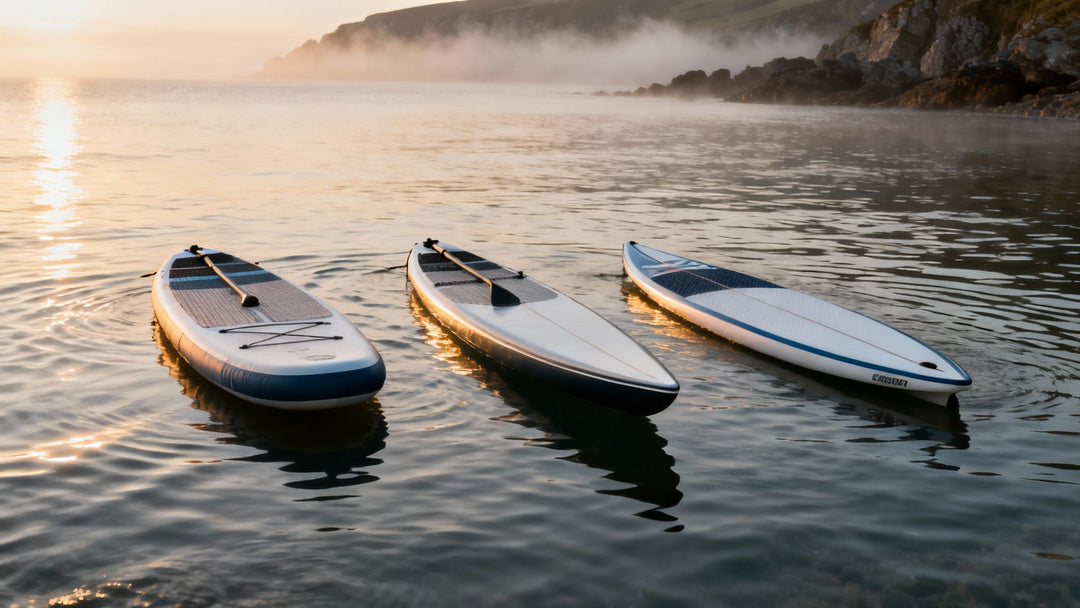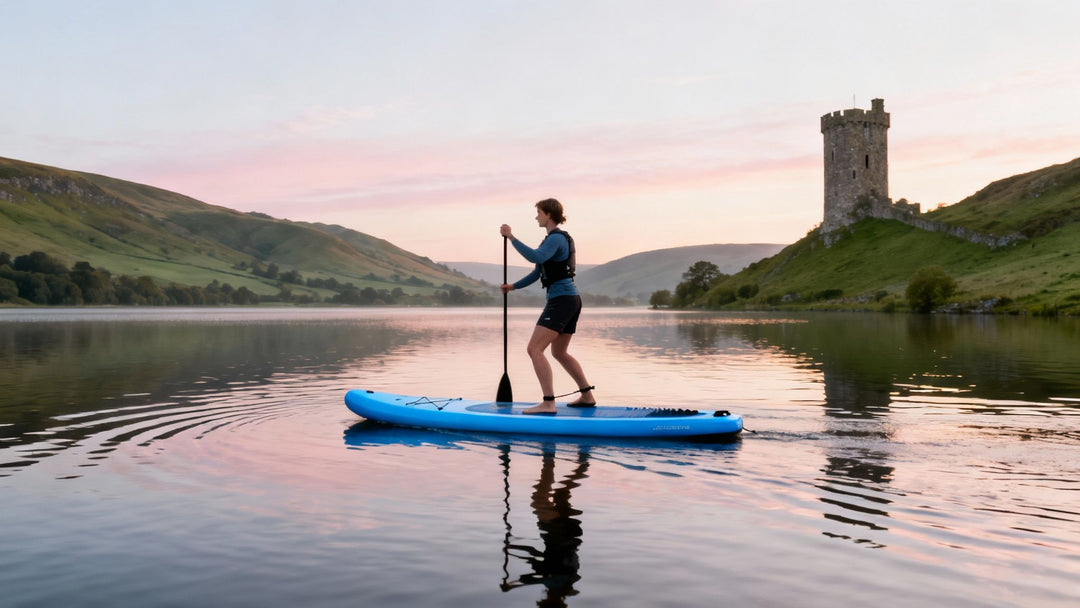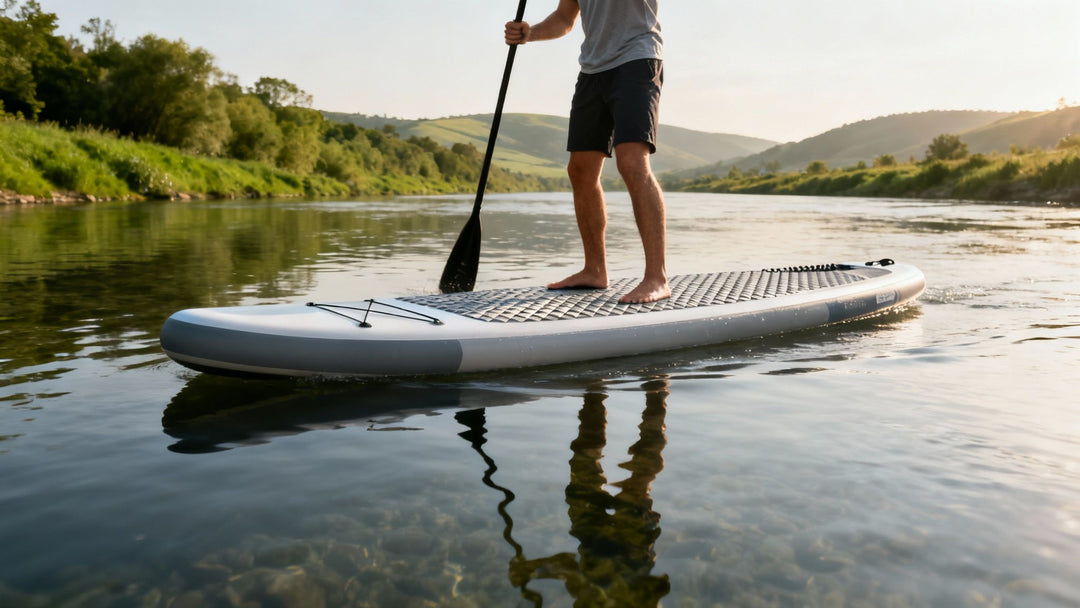Stand Up Paddle Board Reviews The Ultimate UK Guide
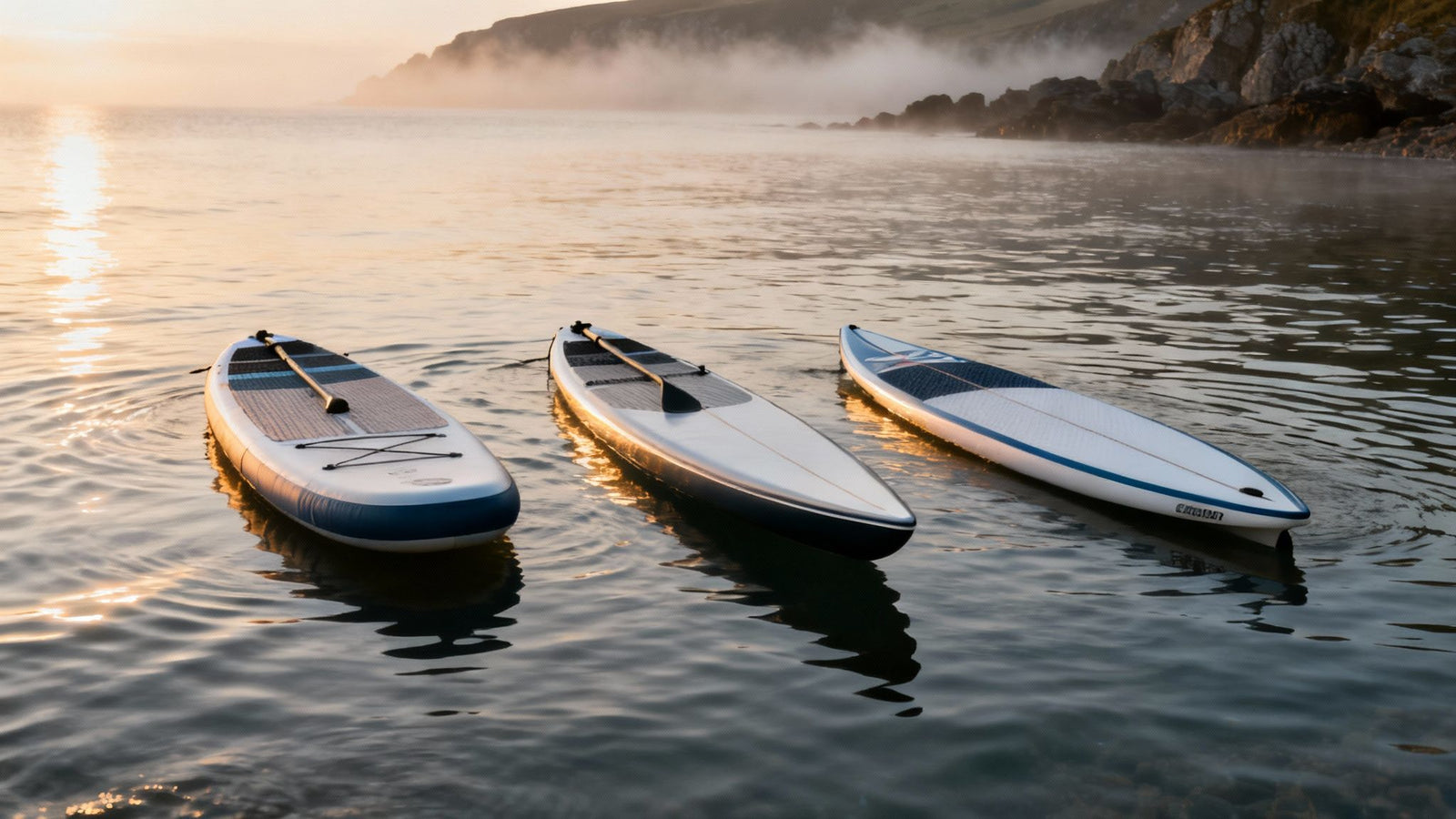
Finding a standout paddle board amid a sea of stand up paddle board reviews can feel like hunting for a needle in a haystack. It’s not about which board tops every list, but which one aligns with your paddling style, storage options and local waters. Picking the right SUP transforms a clunky outing into an effortlessly enjoyable day afloat. For example, a beginner paddling on a calm lake like Windermere needs a different board than an expert tackling waves at Fistral Beach.
How To Choose The Right SUP For UK Waters
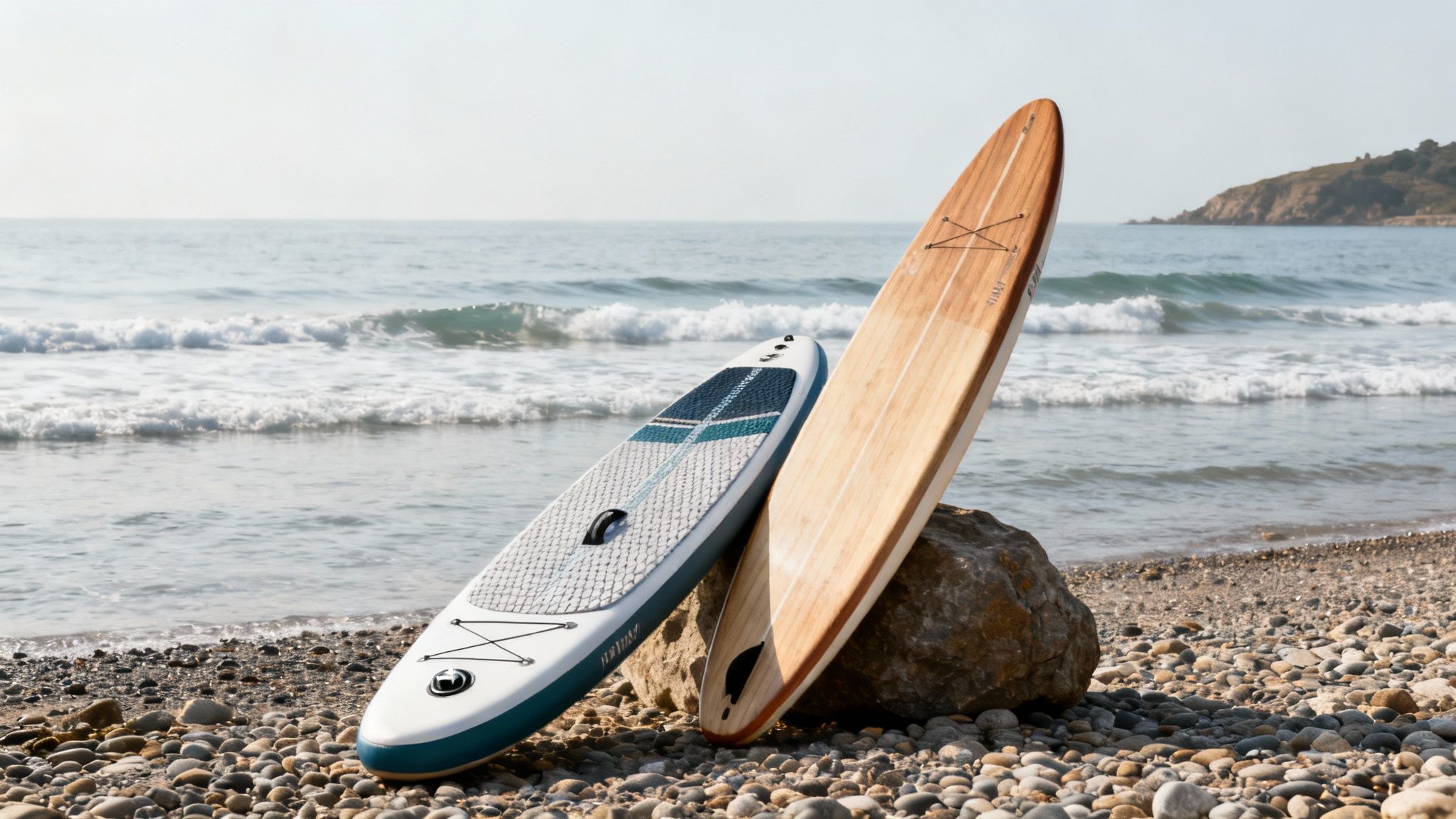
The UK’s waterways vary wildly—from glassy lochs to curving rivers and the bristling chop of coastal bays. Your board needs to be suited to where you’ll paddle most often. Make that first call wisely and you’ll reap the rewards season after season.
At the core of this decision lies one big question: inflatable stand up paddle board (iSUP) or hard (composite) board? Your choice here will ripple through performance, convenience and cost.
Inflatable Vs Hard Boards
Inflatables have surged in popularity and it’s easy to see why:
- Packs into a backpack or car boot for effortless transport
- Fits neatly in flats or sheds with no awkward storage demands
- High-pressure drop-stitch rails deliver surprising rigidity
For instance, the Loco Amigo Air stows away neatly, allowing for a spontaneous trip to a Scottish loch without needing a roof rack. Beginners and mid-level paddlers will appreciate its forgiving stability on calmer waters.
Hard boards, by contrast, slice through water with razor-sharp efficiency:
- Rigid hulls boost speed, glide and responsiveness
- Ideal for SUP surfing and extended coastal runs
- Require dedicated storage space and roof racks
A practical example would be a surfer using a Loco hard surf SUP on the Gower Peninsula; its precise control is essential for carving turns on waves, something an inflatable board struggles to match.
The UK’s share of the European composite SUP market is projected at 21.56% by 2025, reflecting a surge of enthusiasts embracing the sport’s health perks and sheer fun. Learn more about the growth of the composite SUP board market on cognitivemarketresearch.com.
Understanding Board Types
After you decide on inflatable or hard, shapes come into play. Each board profile has a specific purpose, so matching your ambitions is essential. If you’re new to SUP, you can check out our guide on the best inflatable paddle boards for UK waters to find the perfect fit.
Choosing the right type of board is less about finding the 'best' one and more about finding the best one for you. An all-rounder is fantastic for family fun, but it will feel slow and cumbersome if your real ambition is to paddle long coastal routes.
Quick Guide to SUP Types and Ideal Paddlers
Below is a snapshot of common SUP board categories, their standout traits and the paddlers they suit best.
| Board Type | Key Characteristic | Best For | Example Scenario |
|---|---|---|---|
| All-Rounder | Broad, stable profile | Beginners, families | Taking the dog for a paddle on the River Thames or letting the kids jump off at the local beach. |
| Touring | Streamlined nose and length for tracking | Distance paddling, fitness | A multi-day trip along the Norfolk Broads, carrying camping gear. |
| Surf | Pronounced rocker for quick turns | Wave riding | Catching small-to-medium waves at a spot like Croyde Bay in Devon. |
Use this as a starting point, then dive into detailed reviews and real-world tests to narrow down your top picks.
By weighing construction, shape and how you’ll actually use your SUP, you’ll land on a board that feels like it was built just for you—and that’s when the fun truly begins.
Reviewing All-Rounder Paddle Boards
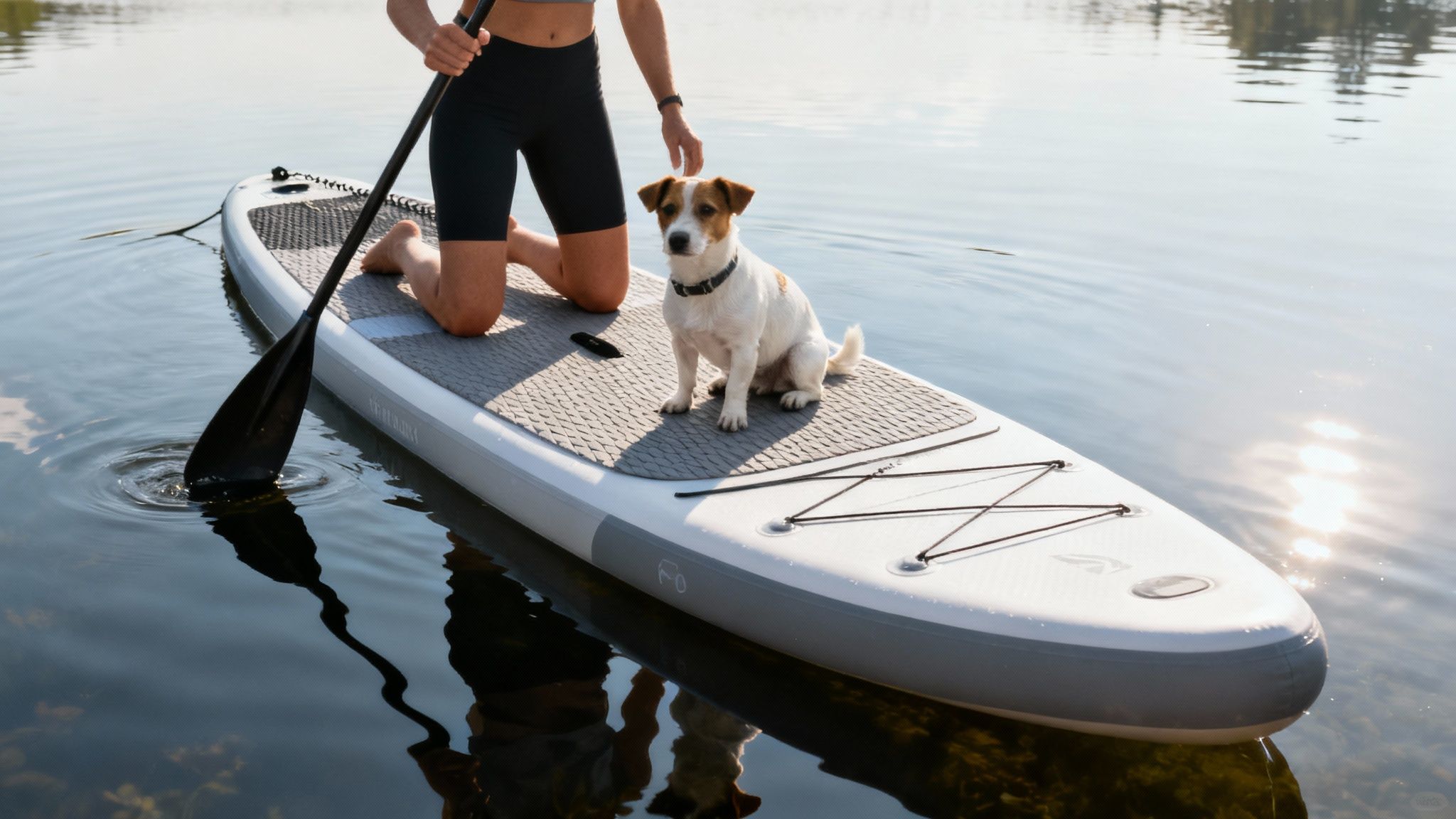
When you want one board that can handle a little bit of everything—river meanders, family outings, even the odd coastal jaunt—an all-rounder is the go-to. In our stand up paddle board reviews, we don’t just stare at specs; we get on the water, feel the board underfoot and see how it reacts to chop, turns and speed.
At the heart of any good all-rounder lie three performance pillars: stability, glide and manoeuvrability. Dimensions matter here. A wider board—around 32–34 inches—gives you that reassuring steadiness, especially if you’re new to SUP or have a dog, a child or a cooler full of drinks aboard.
That said, extra width usually means you sacrifice a bit of speed. This is where thoughtful design and solid build quality step in, lifting some boards from merely decent to genuinely impressive.
Stability And Confidence On The Water
First-timers tend to sweat about balance—and with good reason. A board that wobbles is not a relaxing board. Width sets the initial tone, but rigidity underfoot seals the deal, particularly for inflatables.
Take the Loco Amigo Air as an example. At 32 inches wide, it supports paddlers weighing up to 100 kg without feeling like a trampoline. Its secret? High-grade MSL Fusion or double-layer construction.
Premium all-rounders often use fusion lamination. In practice, that means less flex in choppy water and a more direct feel—almost like a solid hardboard. You get cleaner, more powerful strokes every time.
When a coastal breeze kicks up small waves, this stiffness helps you slice through rather than bob over them. And if you’re sharing the board with kids or friends, that extra firmness makes mounting, dismounting and even a playful shake-down that much more dependable.
Glide And Manoeuvrability A Balancing Act
Once you’re comfortable standing, you’ll notice how differently boards carry speed and execute turns. “Glide” is about maintaining momentum between strokes; “manoeuvrability” is all about those quick direction changes. Naturally, there’s a trade-off.
A nose that tapers into a point improves tracking but demands wider turns. A full, rounded nose lets you spin on a dime but can feel slow over distance. To illustrate, here are two typical use-cases:
| Scenario | Ideal Use Case | Board Traits |
|---|---|---|
| Family Lake Day | Lazy paddles on a calm lake, kids splashing off the side | Broad deck, rounded nose, ultra-stable platform |
| Coastal Explorer | Mile-eating along coves or estuaries with mixed conditions | Slightly slimmer outline, balanced stability and glide |
In practice, if you’re after relaxed fun close to shore, go for maximum width and plenty of buoyancy. If you’re planning miles—maybe a weekend camping trip reachable only from the water—opt for a shape that slices through the swell while still feeling solid.
Before you decide, it pays to check wind and weather patterns. The Met Office’s surface pressure charts are a great resource to see how breeze and barometric shifts might affect your outing. Match the board’s character to your intended adventure, and every paddle stroke will be both efficient and enjoyable.
Comparing the Best Touring SUPs for Adventure
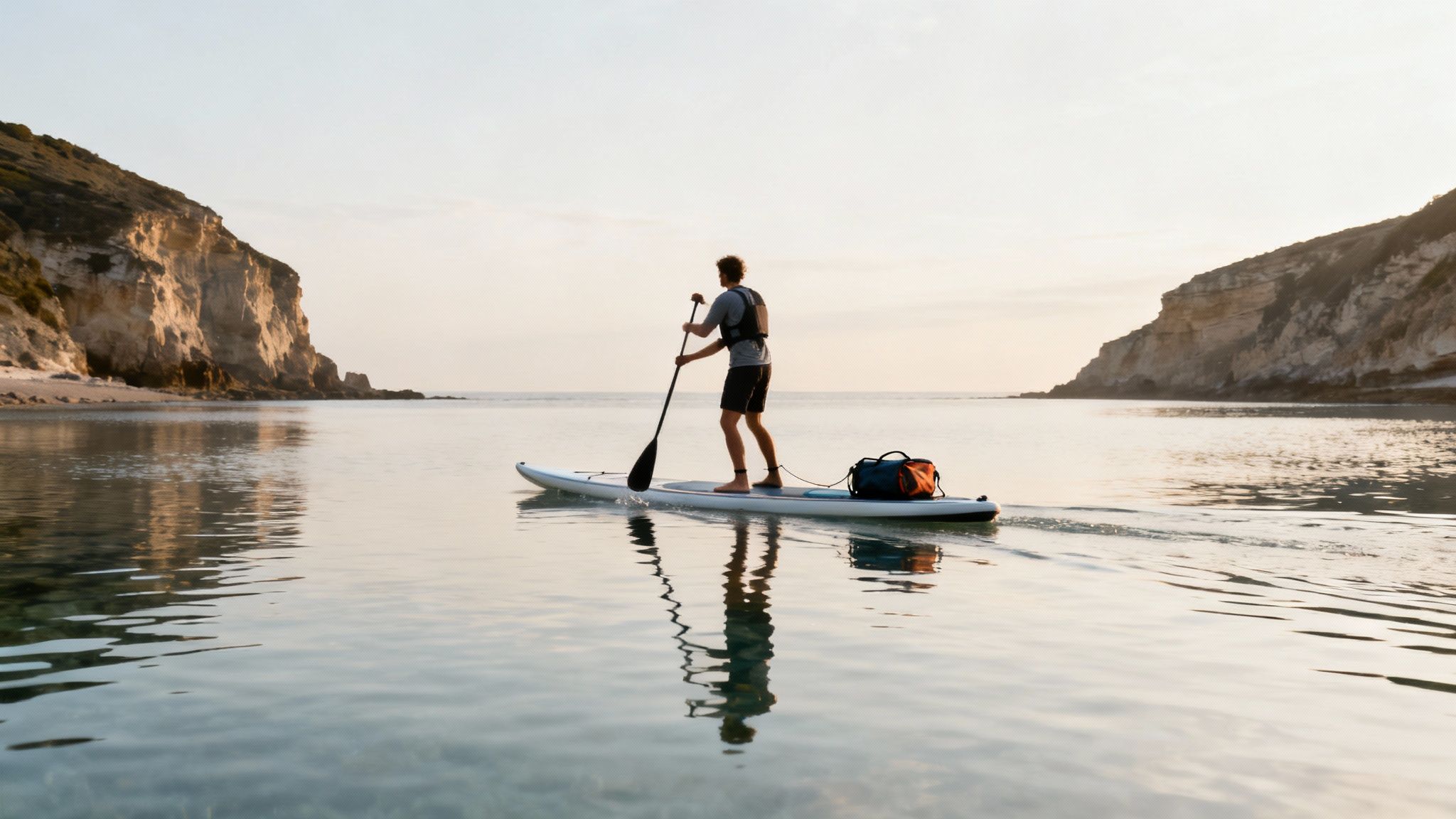
If you're the kind of paddler whose ambitions stretch beyond the local bay, a touring board is your ticket to some proper exploration. Unlike their all-rounder cousins, touring SUPs are built with one thing in mind: covering distance efficiently. Our stand up paddle board reviews of these models get straight to what matters for adventure – glide, tracking, and the space to load up your kit.
You can spot a touring board a mile off. They have longer, narrower shapes and a distinctly pointed nose. This isn't just for show; it's pure physics at play. That streamlined profile helps the board slice through the water with minimal fuss, meaning you cover more ground with less effort.
That efficiency is a game-changer when you're paddling for hours on end, or even over a few days. A board that glides effortlessly conserves your energy, letting you soak in the stunning UK scenery instead of battling against drag.
Glide And Tracking Performance
The real test of a touring board is how well it holds its speed and keeps a straight line. This combination of glide (how far the board travels between paddle strokes) and tracking (its ability to stay on course) is what truly sets a dedicated tourer apart from a recreational board.
Take a board like the Loco Motion Air, for example. It's designed with a length of 12'6" or more, and that extra length makes a massive difference to how well it holds a line. You’ll find yourself switching your paddle from side to side far less often to stay on track.
The trade-off for this incredible efficiency? A slight dip in stability compared to a wider all-rounder. A typical tourer might be 28-30 inches wide, which can feel a bit wobbly at first. But once you find your sea legs, the reward is a faster, more exhilarating paddle.
This design makes touring boards the perfect tool for multi-day expeditions along canals, lochs, or sheltered coastlines. You can get a much deeper understanding of what makes a great distance paddler by checking out our comprehensive guide to touring paddle boards.
Capacity And Practical Features For Expeditions
An adventure without the right gear isn't much of an adventure at all. Touring SUPs come kitted out with features designed specifically for carrying everything you need for a day trip or an overnighter.
You'll want to see plenty of bungee cargo space, usually at both the nose and tail. This is where you'll strap down your dry bags, tent, and cooler without getting in the way of your paddling stance. The best touring models, like the Loco Motion Air, manage to balance this gear capacity with performance, so the board still feels lively even when it’s fully loaded.
Here’s how a touring board’s features make a real difference out on the water:
- Extended Deck Pad: Gives you plenty of grip and comfort when you need to move around the board to access your kit.
- Multiple Bungee Tie-Downs: Absolutely essential for lashing down camping gear for an overnight trip on the River Wye.
- Sleek, Pointed Nose: Helps you cut through choppy water when you’re on a coastal journey, like exploring the Jurassic Coast.
When you're plotting your next big trip, it’s always a good idea to find routes that play to your board’s strengths. Resources like the British Canoeing website are brilliant for finding inspiration for paddle trails across the UK. They really help you visualise exactly where a high-performance touring board can take you. Ultimately, investing in a touring SUP is an investment in bigger, bolder adventures.
High-Performance SUPs for Surf and Racing
When you’re ready to move beyond gentle paddles and seek out breaking waves or sprint to the finish line, an all-rounder simply won’t do. High-performance SUPs are purpose-built, honed for either shredding surf or chasing top speeds. In our stand up paddle board reviews, we focus on the fine details that make a board exceptional.
Stepping into performance paddling means tuning into the design subtleties that govern a board’s behaviour. Surf SUPs prioritise shape and responsiveness, while race boards are engineered around hydrodynamics and pure velocity. These are not minor tweaks—they’re fundamentally different tools for distinct conditions.
To narrow down your choice, follow this decision tree and pinpoint the path that aligns with your paddling ambitions.
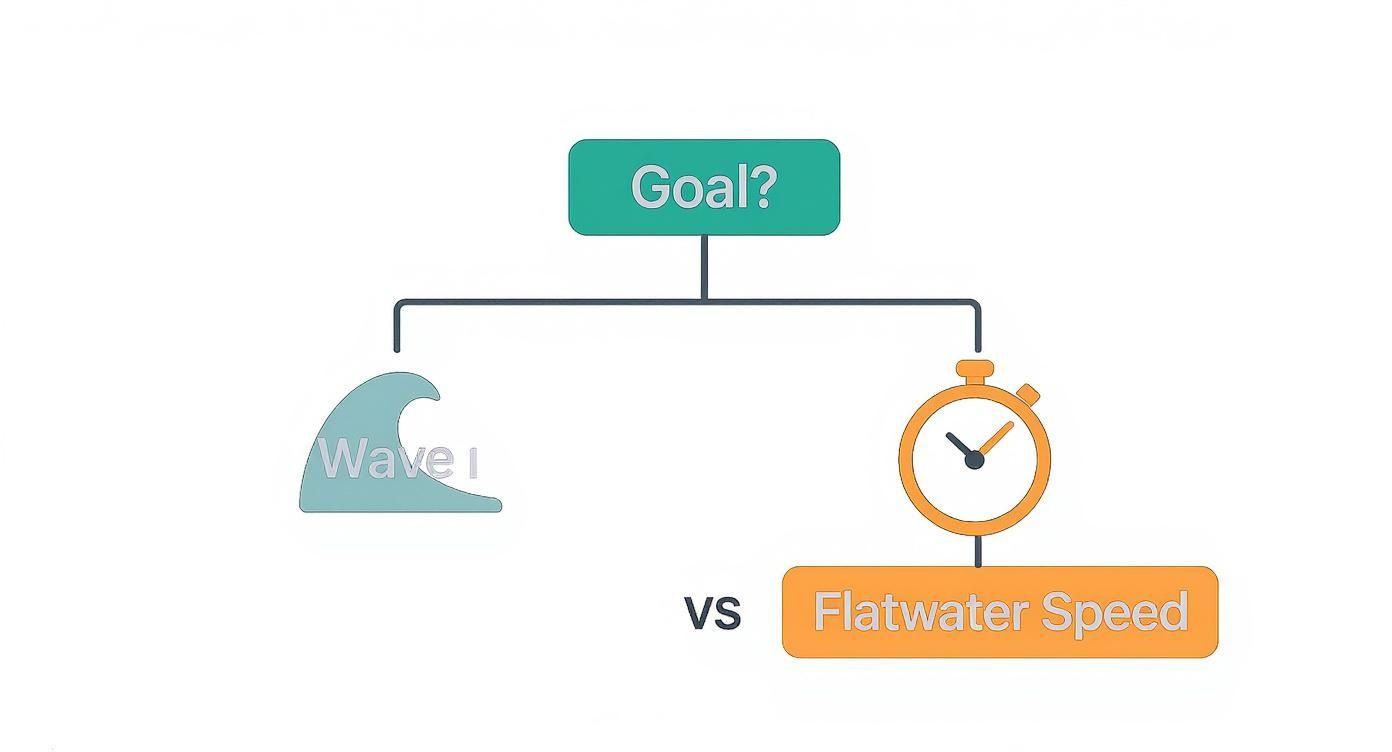
The chart above spells out the two main branches of high-performance paddling, steering you towards the design traits that matter most for wave riding or flatwater speed.
Unpacking SUP Surf Designs
A surf-specific SUP is in a league of its own compared with a standard board. Its contours and curves are carefully balanced to help you catch waves effortlessly and carve with precision.
Key design elements include:
- Rocker Line: The nose-to-tail curve. A pronounced rocker lets the board slot into a wave’s face and pivot on a dime without the nose pearling.
- Rail Shape: The board’s edges. Sharper, slimmer rails bite into the water, offering grip during high-speed carves—much like a snowboard edge in soft snow.
- Tail Design: The outline at the back. A pintail locks you in on larger waves, while a squash tail delivers a looser, park-and-skate feel on gentler rollers.
| Design Element | Purpose | Effect | Practical Example |
|---|---|---|---|
| Rocker Line | Curvature from nose to tail | Sharp turns, reduced pearling | Essential for preventing the nose from diving on steep Cornish waves. |
| Rail Shape | Edge profile | Increased control on carves | Allows for tight, powerful turns on a clean-breaking wave. |
| Tail Design | Rear outline | Balance of hold vs. looseness | A squash tail on a Loco Surf SUP helps with snappy manoeuvres in smaller surf. |
“Blend the right rocker, rails and tail, and you get a board that feels forgiving on take-off yet razor-sharp on the drop.”
For a deeper look at matching these features to your local break and skill level, check out our surf SUP buying advice and tips.
The Science Of SUP Race Boards
Race boards are the greyhounds of the SUP world—long, lean and laser-focused on speed. Every millimetre of the outline is crafted to cut through water with minimal drag.
Essential race-board features:
- Length-to-Width Ratio: Common sizes are 12'6" or 14' long with a beam of 21–24 inches. This extended waterline boosts glide per stroke.
- Hull Shape: A displacement hull sports a sharp, slicing nose that maintains momentum in both placid and choppy conditions.
- Stiffness: Carbon-fibre construction keeps the board rigid and light. Less flex means more power from each paddle stroke goes straight into forward motion.
| Aspect | Surf SUP | Race SUP |
|---|---|---|
| Primary Focus | Manoeuvrability | Straight-line Speed |
| Typical Length | 9'0" – 10'6" | 12'6", 14' |
| Typical Width | 30" – 32" | 21–24 inches |
| Hull Profile | Rocker Curve | Displacement |
| Construction | Balanced Flex | Carbon-fibre Stiff |
If you’re battling choppy beach breaks in the UK, a surf SUP with extra volume will give you the stability you need. On the other hand, if your training ground is a calm loch or lazy river, the blistering glide of a narrow race board will push your performance to the next level.
Your Guide to Making the Final Decision
Sifting through stand up paddle board reviews can leave your head spinning. But now we get to the simple bit: matching the right board to your life. We're shifting the focus from the gear back to you, because what really matters are your plans, your storage space, and your budget.
Getting this part right is the difference between a board that gathers dust and one that creates memories. There’s no point owning a high-performance surf SUP if your paddling is limited to lazy rivers. Likewise, a massive hard board is just a headache if you live in a top-floor flat.
Let's cut through the noise and figure out what you genuinely need, so you can invest in a board that will be your ticket to countless adventures on the water.
What’s Your 80%?
Before pulling the trigger, be honest with yourself. Where will you be paddling 80% of the time? Is it weekend jaunts with the family? Solo fitness sessions after work? Or are you dreaming of multi-day expeditions? Your answer points you directly to the right board.
- Family Fun and Casual Paddles: Stability and durability are your best friends. You want a forgiving platform that can handle kids, dogs, and the odd wobble. A wide, stable all-rounder like the Loco Amigo Air is perfect for this.
- Fitness and Exploring: Here, it’s all about efficiency. A touring board’s longer, sleeker shape cuts through the water, letting you cover more ground with less effort. It’s the ideal choice for exploring new coastlines or cruising down long stretches of river.
- Adrenaline and Performance: If you’re all about catching waves or racing, then a specialised board is a must. The specific shapes of surf or race SUPs are built for speed and agility in challenging conditions. Anything else just won’t cut it.
The global SUP market is booming, with forecasts predicting it will be worth between $2.8 billion and $3.77 billion by 2033. This explosion in popularity, especially in the UK, has made the sport more accessible than ever. There are more rental spots and guided tours, giving you a fantastic opportunity to try before you buy. You can dig into more stats about the expanding SUP market on archivemarketresearch.com.
Let's Get Practical
Beyond how a board performs, you need to think about the day-to-day realities. Where will you store it? How will you get it to the water? This is where the inflatable versus hard board debate usually gets settled.
If you’re short on space but have big plans for long-distance paddles, a top-tier inflatable touring board is your answer. Something like the Loco Motion Air delivers fantastic performance without needing a garage or a roof rack. It’s the best of both worlds for the paddler who is adventurous but also space-conscious.
Let’s break down the main choices to make it crystal clear.
SUP Recommendation Matrix
To help you visualise how different boards stack up against what you might need, we've put together this simple matrix. It cuts right to the chase, comparing our top-reviewed boards for different types of paddlers.
| Board Model (inc. Loco) | Primary Use Case | Skill Level | Stability Rating (1-5) | Portability Rating (1-5) | Performance Focus |
|---|---|---|---|---|---|
| Loco Amigo Air | All-Round Family Fun | Beginner - Intermediate | 5 | 5 | Versatility & Stability |
| Generic Touring iSUP | Distance & Fitness Paddling | Intermediate - Advanced | 4 | 5 | Glide & Tracking |
| Loco Motion Air | Expeditions & Fast Touring | Intermediate - Advanced | 4 | 5 | Efficiency & Speed |
| Performance Surf SUP | Wave Riding | Intermediate - Expert | 3 | 2 (Hard Board) | Manoeuvrability & Control |
| Race Board | Competitive Racing & Speed | Advanced - Expert | 2 | 2 (Hard Board) | Maximum Velocity |
This table makes the decision process a whole lot easier. If your main goal is paddling on the local lake with family (Stability: 5) and you need to throw the board in the car boot (Portability: 5), the Loco Amigo Air clearly stands out. On the flip side, if you're chasing pure speed and have a way to transport a long, rigid board, then a dedicated race SUP is where your money should go.
By boiling down all the detailed stand up paddle board reviews into this straightforward framework, you can now make your choice with confidence. You're not just buying a piece of kit; you're investing in the key to unlocking the exact kind of freedom on the water you've been dreaming about.
Got Questions About Picking a SUP?
Choosing the right board after scrolling through endless stand up paddle board reviews can feel like the toughest bit of the journey. To help you make that final decision with complete confidence, we've pulled together the questions we get asked the most. This should clear up any last-minute wobbles and get you on the perfect board.
What’s the Real Difference Between a Cheap SUP and a Premium One?
It's a question we hear all the time: why shell out more for one board when another looks almost the same for half the price? The honest answer is it all comes down to the stuff you can't see – construction, materials, performance, and how long it'll last. These factors completely change your experience on the water.
Cheaper boards are usually built with a basic, single-layer of PVC. While it keeps the price down, it often leads to a board that's not very stiff. You'll feel this on the water as a noticeable flex, especially in choppy conditions. It creates a bouncy, unstable feeling that really kills your glide.
On the other hand, premium brands like Loco Surfing are using much more advanced manufacturing.
- MSL Fusion Construction: This is a game-changer. A second layer of high-density PVC is machine-laminated directly onto the core. This process removes the risk of human error and uses far less glue, making the board up to 5 lbs lighter while being massively stiffer.
- Double-Layer Construction: This is another top-end method where a second layer is meticulously glued on by hand, adding serious toughness and rigidity.
That superior stiffness means a premium board, like a Loco board, feels and performs much more like a traditional hard board. You get a smoother glide, way more stability, and a board that's built to last season after season. Even the accessories like the pump, bag, and paddle are a step up in quality, so you know you've got a reliable setup from day one.
Inflatable or Hard Board: Which Is Better for UK Waters?
This one really boils down to what you value more: ultimate convenience or peak performance. For the vast majority of paddlers here in the UK, a quality inflatable SUP is simply the most practical option.
Their portability is a massive plus. You can chuck an inflatable in the boot of your car to go exploring in the Lake District, find a remote Scottish loch, or paddle a sheltered Cornish cove, all without messing about with roof racks. Storing them is a doddle too – they just pack away in a cupboard or the shed.
For most recreational UK paddlers, a quality inflatable offers the best balance of performance and practicality. They are incredibly versatile and allow you to explore a huge variety of waterways with minimal fuss.
However, hard boards (or composite boards) are still the undisputed kings of on-water performance. They slice through the water with better speed, glide, and responsiveness, which you'll really notice if you're trying to catch some waves. If you're lucky enough to live right by the water, have plenty of storage, and performance is your absolute number one, then a hard board is a fantastic investment.
How Do I Choose The Right Size SUP?
Getting the right size board is absolutely critical for your stability and enjoyment, and it's mostly determined by your weight and height. The three things to look at are volume, length, and width.
A board's volume, measured in litres, tells you how buoyant it is. It needs enough volume to float you comfortably. Manufacturers will almost always give a recommended rider weight range, and that's the best place to start. For more on the safety side of things, the paddleboarding experts at the RNLI have some great advice.
When it comes to width, most all-round boards sit between 32-34 inches. This gives you a nice, stable platform that’s perfect for beginners. The length changes how the board moves through the water.
- Longer boards (11’ and up): These track in a straight line better and are faster, which is what you want for touring.
- Shorter boards (under 10’): These are way more nimble and easier to turn, making them ideal for SUP surfing.
As a rule of thumb, stick to the manufacturer's weight guides. If you're a beginner feeling a bit nervous, or you plan on taking a child or dog along for the ride, choosing a board with a bit more volume and width is always a smart move.
What Essential Kit Do I Need to Start Paddling?
Most SUP packages will give you the board, a paddle, and a pump, but there are a few other bits of gear that are non-negotiable for paddling safely and happily in the UK.
Your most important accessory is a leash. This simple bit of kit keeps you tethered to your board if you fall in, which can be a lifesaver, especially if it's windy or there's a current. A personal flotation device (PFD) or buoyancy aid is also strongly recommended by every water safety organisation out there.
Beyond those absolute must-haves, you should think about comfort.
- What to Wear: A wetsuit is a good call for most of the year in the UK, as our water can be chilly! In the height of summer, some quick-drying sportswear might do the trick.
- Dry Bag: An essential for keeping your phone, keys, and snacks from getting soaked while you're out on the water.
- Waterproof Phone Case: A great little investment for peace of mind and for getting those perfect on-water photos without risking your phone.
Getting this extra kit sorted from the get-go means you can hit the water ready for anything, leaving you to just relax and enjoy the paddle.
Ready to find the board that will make every moment on the water better? Explore the full range of performance-driven SUPs and get expert advice at Loco Surfing. Whether you’re just starting out or you’re a seasoned pro, we have the perfect board to match your ambition. Discover your next SUP today.


